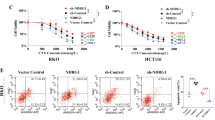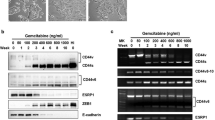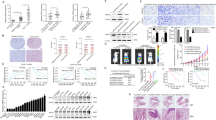Abstract
Resistance to chemotherapy is a major obstacle for curative treatment of human gastric cancer (GC). However, the underlying molecular mechanisms are largely unknown. Wingless-type MMTV integration site family members (WNTs) are secreted glycoproteins involved in embryogenesis and, on inappropriate expression in the adult, in cancer. Here, we show expression of WNT6 in GC patient specimens, human GC cell lines and in a mouse model of GC. In human GC cells, WNT6 expression was enhanced by caveolin-1 (Cav1), a scaffold protein of plasma membrane caveolae. WNT6 knock-down and overexpression experiments demonstrated that WNT6 increased the resistance to apoptotic cell death induced by the anthracycline chemotherapeutics epirubicin (Epi) and doxorubicin (Dox). Epi increased the activity of the human WNT6 promoter through Cav1-dependent binding of β-catenin to the proximal WNT6 promoter. Epi increased both WNT6/Wnt6 and Cav1 expression in human GC cells and within the tumor area of a murine model of GC (CEA424-SV40 TAg). In GC patients, WNT6 expression was positively associated with the tumor stage and the nodal status, and inversely correlated with the response to ECF (Epi, cisplatin, 5-fluorouracil) chemotherapy. These results showed that WNT6 and Cav1 are upregulated by chemotherapeutics and enhance the resistance of GC cells to anthracycline drugs. Understanding the molecular mechanisms driving WNT6/Cav1-induced drug resistance will provide benefits in developing new therapies for GC.
This is a preview of subscription content, access via your institution
Access options
Subscribe to this journal
Receive 50 print issues and online access
$259.00 per year
only $5.18 per issue
Buy this article
- Purchase on Springer Link
- Instant access to full article PDF
Prices may be subject to local taxes which are calculated during checkout









Similar content being viewed by others
Abbreviations
- WNT:
-
wingless-type MMTV integration site family member
- GC:
-
gastric cancer
- Cav1:
-
caveolin-1
- TCF:
-
transcription factor 4
- Dox:
-
doxorubicin
- Epi:
-
epirubicin
- 5-FU:
-
5-fluorouracil
- ECF:
-
epirubicin/cisplatin/5-fluorouracil.
References
Kelley JR, Duggan JM . Gastric cancer epidemiology and risk factors. J Clin Epidemiol 2003; 56: 1–9.
Jemal A, Center MM, DeSantis C, Ward EM . Global patterns of cancer incidence and mortality rates and trends. Cancer Epidemiol Biomarkers Prev 2010; 19: 1893–1907.
Becker K, Langer R, Reim D, Novotny A, Meyer Zum Buschenfelde C, Engel J et al. Significance of histopathological tumor regression after neoadjuvant chemotherapy in gastric adenocarcinomas: a summary of 480 cases. Ann Surg 2011; 253: 934–939.
Cunningham D, Allum WH, Stenning SP, Thompson JN, Van de Velde CJ, Nicolson M et al. Perioperative chemotherapy versus surgery alone for resectable gastroesophageal cancer. N Engl J Med 2006; 355: 11–20.
Cunningham D, Starling N, Rao S, Iveson T, Nicolson M, Coxon F et al. Capecitabine and oxaliplatin for advanced esophagogastric cancer. N Engl J Med 2008; 358: 36–46.
Logan CY, Nusse R . The WNT signaling pathway in development and disease. Annu Rev Cell Dev Biol 2004; 20: 781–810.
Clevers H . Wnt/beta-catenin signaling in development and disease. Cell 2006; 127: 469–480.
Wei Y, Fabre M, Branchereau S, Gauthier F, Perilongo G, Buendia MA . Activation of beta-catenin in epithelial and mesenchymal hepatoblastomas. Oncogene 2000; 19: 498–504.
Taniguchi K, Roberts LR, Aderca IN, Dong X, Qian C, Murphy LM et al. Mutational spectrum of beta-catenin, AXIN1, and AXIN2 in hepatocellular carcinomas and hepatoblastomas. Oncogene 2002; 21: 4863–4871.
Hadjihannas MV, Brückner M, Jerchow B, Birchmeier W, Dietmaier W, Behrens J . Aberrant WNT/beta-catenin signaling can induce chromosomal instability in colon cancer. Proc Natl Acad Sci USA 2006; 103: 10747–10752.
Asciutti S, Akiri G, Grumolato L, Vijayakumar S, Aaronson SA . Diverse mechanisms of WNT activation and effects of pathway inhibition on proliferation of human gastric carcinoma cells. Oncogene 2011; 30: 956–966.
Kikuchi A, Yamamoto H, Sato A . Selective activation mechanisms of Wnt signaling pathways. Trends Cell Biol 2009; 19: 119–129.
Kobune M, Chiba H, Kato J, Kato K, Nakamura K, Kawano Y et al. Wnt3/RhoA/ROCK signaling pathway is involved in adhesion-mediated drug resistance of multiple myeloma in an autocrine mechanism. Mol Cancer Ther 2007; 6: 1774–1784.
Flahaut M, Meier R, Coulon A, Nardou KA, Niggli FK, Martinet D et al. The Wnt receptor FZD1 mediates chemoresistance in neuroblastoma through activation of the Wnt/beta-catenin pathway. Oncogene 2009; 28: 2245–2256.
Noda T, Nagano H, Takemasa I, Yoshioka S, Murakami M, Wada H et al. Activation of Wnt/beta-catenin signalling pathway induces chemoresistance to interferon-alpha/5-fluorouracil combination therapy for hepatocellular carcinoma. Br J Cancer 2009; 100: 1647–1658.
Nyeng P, Norgaard GA, Kobberup S, Jensen J . FGF10 signaling controls stomach morphogenesis. Dev Biol 2007; 303: 295–310.
Krawetz R, Kelly GM . WNT6 induces the specification and epithelialization of F9 embryonal carcinoma cells to primitive endoderm. Cell Signal 2008; 20: 506–517.
Kirikoshi H, Sekihara H, Katoh M . WNT10A and WNT6, clustered in human chromosome 2q35 region with head-to-tail manner, are strongly coexpressed in SW480 cells. Biochem Biophys Res Commun 2001; 283: 798–805.
Razani B, Woodman SE, Lisanti MP . Caveolae: from cell biology to animal physiology. Pharmacol Rev 2002; 54: 431–467.
Parton RG, Simons K . The multiple faces of caveolae. Nat Rev Mol Cell Biol 2007; 8: 185–194.
Anderson RG, Jacobson K . A role for lipid shells in targeting proteins to caveolae, rafts, and other lipid domains. Science 2002; 296: 1821–1825.
Williams TM, Lisanti MP . Caveolin-1 in oncogenic transformation, cancer, and metastasis. Am J Physiol Cell Physiol 2005; 288: C494–C506.
Burgermeister E, Xing X, Röcken C, Juhasz M, Chen J, Hiber M et al. Differential expression and function of caveolin-1 in human gastric cancer progression. Cancer Res 2007; 67: 8519–8526.
Lavie Y, Fiucci G, Liscovitch M . Up-regulation of caveolae and caveolar constituents in multidrug-resistant cancer cells. J Biol Chem 1998; 273: 32380–32383.
Yang CP, Galbiati F, Volonte D, Horwitz SB, Lisanti MP . Upregulation of caveolin-1 and caveolae organelles in Taxol-resistant A549 cells. FEBS Lett 1998; 439: 368–372.
Bélanger MM, Gaudreau M, Roussel E, Couet J . Role of caveolin-1 in etoposide resistance development in A549 lung cancer cells. Cancer Biol Ther 2004; 3: 954–959.
Ho CC, Kuo SH, Huang PH, Huang HY, Yang CH, Yang PC . Caveolin-1 expression is significantly associated with drug resistance and poor prognosis in advanced non-small cell lung cancer patients treated with gemcitabine-based chemotherapy. Lung Cancer 2008; 59: 105–110.
Shatz M, Liscovitch M . Caveolin-1 and cancer multidrug resistance: coordinate regulation of pro-survival proteins? Leuk Res 2004; 28: 907–908.
Joo HJ, Oh DK, Kim YS, Lee KB, Kim SJ . Increased expression of caveolin-1 and microvessel density correlates with metastasis and poor prognosis in clear cell renal cell carcinoma. BJU Int 2004; 93: 291–296.
Barresi V, Cerasoli S, Paioli G, Vitarelli E, Giuffrè G, Guiducci G et al. Caveolin-1 in meningiomas: expression and clinico-pathological correlations. Acta Neuropathol 2006; 112: 617–626.
Karam JA, Lotan Y, Roehrborn CG, Ashfaq R, Karakiewicz PI, Shariat SF . Caveolin-1 overexpression is associated with aggressive prostate cancer recurrence. Prostate 2007; 67: 614–622.
Du ZM, Hu CF, Shao Q, Huang MY, Kou CW, Zhu XF et al. Upregulation of caveolin-1 and CD147 expression in nasopharyngeal carcinoma enhanced tumor cell migration and correlated with poor prognosis of the patients. Int J Cancer 2009; 125: 1832–1841.
Burgermeister E, Friedrich T, Hitkova I, Gruner-Regel I, Einwächter H, Zimmermann W et al. The ras inhibitors caveolin-1 and docking protein-1 activate PPARgamma through spatial relocalization at helix-7 of its ligand-binding domain. Mol Cell Biol 2011; 31: 3497–3510.
Kang HC, Kim IJ, Park JH, Shin Y, Ku JL, Jung MS et al. Identification of genes with differential expression in acquired drug-resistant gastric cancer cells using high-density oligonucleotide microarrays. Clin Cancer Res 2004; 10: 272–284.
Burrus LM, McMahon AP . Biochemical analysis of murine WNT proteins reveals both shared and distinct properties. Exp Cell Res 1995; 220: 363–373.
Thompson J, Epting T, Schwarzkopf G, Singhofen A, Eades-Perner AM, van Der Putten H et al. A transgenic mouse line that develops early-onset invasive gastric gastric carcinoma provides a model for carcinoembryonic antigen-targeted tumor therapy. Int J Cancer 2000; 86: 863–869.
Bourquin C, von der Borch P, Zoglmeier C, Anz D, Sandholzer N, Suhartha N et al. Efficient eradication of subcutaneous but not of autochthonous gastric tumors by adoptive T cell transfer in an SV40 T antigen mouse model. J Immunol 2010; 185: 2580–2588.
Becker K, Muller JD, Schulmacher C, Ott K, Fink U, Busch R et al. Histomorphology and grading of regression in gastric carcinoma treated with neoadjuvant chemotherapy. Cancer 2003; 98: 1521–1530.
Hausmann G, Bänziger C, Basler K . Helping Wingless take flight: how WNT proteins are secreted. Nat Rev Mol Cell Biol 2007; 8: 331–336.
Conner SD, Schmid SL . Regulated portals of entry into the cell. Nature 2003; 422: 37–44.
Yamamoto H, Komekado H, Kikuchi A . Caveolin is necessary for WNT-3a-dependent internalization of LRP6 and accumulation of beta-catenin. Dev Cell 2006; 11: 213–223.
Bilic J, Huang YL, Davidson G, Zimmermann T, Cruciat CM, Bienz M et al. WNT induces LRP6 signalosomes and promotes dishevelled-dependent LRP6 phosphorylation. Science 2007; 316: 1619–1622.
Galbiati F, Volonte D, Brown AM, Weinstein DE, Ben-Ze'ev A, Pestell RG et al. Caveolin-1 expression inhibits WNT/beta-catenin/Lef-1 signaling by recruiting beta-catenin to caveolae membrane domains. J Biol Chem 2000; 275: 23368–23377.
Dvory-Sobol H, Sagiv E, Liberman E, Kazanov D, Arber N . Suppression of gastric cancer cell growth by targeting the beta-catenin/T-cell factor pathway. Cancer 2007; 109: 188–197.
Huang J, Yang J, Maity B, Mayuzumi D, Fisher RA . Regulator of G protein signaling 6 (RGS6) mediates doxorubicin-induced ATM and p53 activation by a reactive oxygen species (ROS)-dependent mechanism. Cancer Res 2011; 71: 6310–6319.
Millour J, de Olano N, Horimoto Y, Monteiro LJ, Langer JK, Aligue R et al. ATM and p53 regulate FOXM1 expression via E2F in breast cancer epirubicin treatment and resistance. Mol Cancer Ther 2011; 10: 1046–1058.
Bist A, Fielding CJ, Fielding PE . p53 regulates caveolin gene transcription, cell cholesterol, and growth by a novel mechanism. Biochemistry 2000; 39: 1966–1972.
Li Q, Lin S, Wang X, Lian G, Lu Z, Guo H et al. Axin determines cell fate by controlling the p53 activation threshold after DNA damage. Nat Cell Biol 2009; 11: 1128–1134.
Lee KH, Li M, Michalowski AM, Zhang X, Liao H, Chen L et al. A genomewide study identifies the Wnt signaling pathway as a major target of p53 in murine embryonic stem cells. Proc Natl Acad Sci USA 2010; 107: 69–74.
Goetz JG, Lajoie P, Wiseman SM, Nabi IR . Caveolin-1 in tumor progression: the good, the bad and the ugly. Cancer Metastasis Rev 2008; 27: 715–735.
Kurayoshi M, Oue N, Yamamoto H, Kishida M, Inoue A, Asahara T et al. Expression of Wnt-5a is correlated with aggressiveness of gastric cancer by stimulating cell migration and invasion. Cancer Res 2006; 66: 10439–10448.
Yamamoto H, Kitadai Y, Yamamoto H, Oue N, Ohdan H, Yasui W et al. Laminin gamma2 mediates Wnt5a-induced invasion of gastric cancer cells. Gastroenterology 2009; 137: 242–252.
Ordway JM, Bedell JA, Citek RW, Nunberg A, Garrido A, Kendall R et al. Comprehensive DNA methylation profiling in a human cancer genome identifies novel epigenetic targets. Carcinogenesis 2006; 27: 2409–2423.
Fiucci G, Ravid D, Reich R, Liscovitch M . Caveolin-1 inhibits anchorage-independent growth, anoikis and invasiveness in MCF-7 human breast cancer cells. Oncogene 2002; 21: 2365–2375.
Ravid D, Maor S, Werner H, Liscovitch M . Caveolin-1 inhibits cell detachment-induced p53 activation and anoikis by upregulation of insulin-like growth factor-1 receptors and signaling. Oncogene 2005; 24: 1338–1347.
Chen J, Röcken C, Hoffmann J, Krüger S, Lendeckel U, Rocco A et al. Expression of carbonic anhydrase 9 at the invasion front of gastric cancers. Gut 2005; 54: 920–927.
Ebert MP, Fei G, Kahmann S, Müller O, Yu J, Sung JJ et al. Increased beta-catenin mRNA levels and mutational alterations of the APC and beta-catenin gene are present in intestinal-type gastric cancer. Carcinogenesis 2002; 23: 87–91.
Burgermeister E, Schnoebelen A, Flament A, Benz J, Stihle M, Gsell B et al. A novel partial agonist of peroxisome proliferator-activated receptor-gamma (PPARgamma) recruits PPARgamma-coactivator-1alpha, prevents triglyceride accumulation, and potentiates insulin signaling in vitro. Mol Endocrinol 2006; 20: 809–830.
Acknowledgements
We are grateful to Minhu Chen, Xiao Chen, Jie Chen for support on collaborations. M Ebert is supported by grants from the Deutsche Krebshilfe (107885, 108096), the DFG (SFB 824, TP B1), the Else Kröner Stiftung (Nr P14/07//A104/06), the BMBF (Mobimed 01EZ0802 and KMU-innovativ Initiative of the BMBF No 0315116B). E Burgermeister receives funds from the Deutsche Krebshilfe (108287) and DFG (BU-2285).
Author information
Authors and Affiliations
Corresponding author
Ethics declarations
Competing interests
The authors declare no conflict of interest.
Additional information
Supplementary Information accompanies the paper on the Oncogene website
Rights and permissions
About this article
Cite this article
Yuan, G., Regel, I., Lian, F. et al. WNT6 is a novel target gene of caveolin-1 promoting chemoresistance to epirubicin in human gastric cancer cells. Oncogene 32, 375–387 (2013). https://doi.org/10.1038/onc.2012.40
Received:
Revised:
Accepted:
Published:
Issue Date:
DOI: https://doi.org/10.1038/onc.2012.40
Keywords
This article is cited by
-
Alternative Wnt-signaling axis leads to a break of oncogene-induced senescence
Cell Death & Disease (2024)
-
A comprehensive insight into the correlation between ncRNAs and the Wnt/β-catenin signalling pathway in gastric cancer pathogenesis
Cell Communication and Signaling (2023)
-
Stabilizing and upregulating Axin with tankyrase inhibitor reverses 5-fluorouracil chemoresistance and proliferation by targeting the WNT/caveolin-1 axis in colorectal cancer cells
Cancer Gene Therapy (2022)
-
Increased ERK phosphorylation and caveolin-1 expression on K562 human chronic myelogenous leukemia cells by jacalin, a dietary plant lectin
Glycoconjugate Journal (2021)
-
Circular RNA circCCDC9 acts as a miR-6792-3p sponge to suppress the progression of gastric cancer through regulating CAV1 expression
Molecular Cancer (2020)



